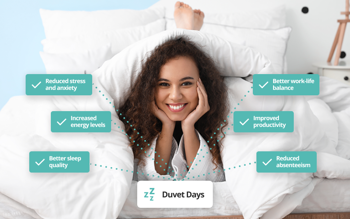
Over the past few years, the prevalence of sick days in the workplace has been steadily increasing, with stress and burnout being the biggest causes. To address this concerning HR trend, some organisations have introduced the concept of ‘duvet days’ to support employees’ mental health and prevent penalisation for taking time off.
In this article, we’ll look at this type of day off in more detail, and explore the benefits they offer, as well as how HR professionals should track duvet days to create a healthier work environment. Let’s start with the most important question: What is a duvet day at work, and how does it differ from a sick day?
What is a duvet day?
A duvet day is a day off that an employee can take without agreeing it in advance. They are built into the company policy along with holiday and sick leave, and can be used when an employee isn’t sick but doesn’t feel up to going to work. Common reasons for taking a duvet day include tiredness, stress or anxiety.
Benefits of taking a duvet day
There are many instances where a person may not feel up to attending work, but not unwell enough to call in sick. Where employees have a limited number of paid sick days, the choice of whether to use them on something relatively minor can be tough. In these instances, employees can opt to take a duvet day, meaning that they can save their sick days and holiday entitlement.
Taking a duvet day offers more flexibility and several benefits for employees, including:
- Reduced stress and anxiety
- Improved mood and mental wellbeing
- Increased energy levels
- Better sleep quality
- Better work-life balance
With absences relating to mental health on the rise, it’s important for businesses to put meaningful measures in place to support employees in the workplace. As well as providing a better experience for their staff, employers offering duvet days can see a wide range of benefits, such as:
- Improved productivity
- Reduced absenteeism
- Increased morale
- Fewer cases of employee burnout
- Increased retention
- Better engagement
When employees should take a duvet day
With the culture of long hours killing motivation, offering a flexible solution for those days when employees just don’t feel up to it helps to reduce the risk of burnout. There’s no right or wrong time for an employee to take a duvet day. However, it’s important to note the differences between duvet days and sick days, and to make sure that they are outlined clearly in your company policy.
While a sick day would be used for an illness that prevents a person from being able to attend work, or that could be contagious, a duvet day is for the times when an employee just needs a bit of a break. This could be if they’re feeling stressed, or if they’ve had a poor night’s sleep and don’t feel at their best.
How to discuss duvet days with employees
The most important part of managing duvet days is setting clear expectations. That means helping employees understand what a duvet day is, when it should be used, how many they are entitled to each year, and how they differ from sick days and annual leave.
Here are some key steps to follow when introducing duvet days in your organisation:
- Introduce the concept of duvet days
- Explain the benefits of duvet days
- Set clear guidelines for taking duvet days
- Encourage employees to take duvet days
- Respect employees’ privacy
Mutual trust is essential for duvet days to be successful. As well as giving employees the benefit of the doubt that they have a legitimate reason for taking an unexpected day off, be wary of contacting employees when they’re off sick.
How to track your duvet days
Just like any other type of employee absence, you need to keep track of duvet days taken by employees. It’s important to separate this type of day off from normal sick days and annual leave to make sure they’re not being overused or taken advantage of. As well as ensuring that you know who is in attendance for admin and safety purposes, reviewing the use of duvet days can help HR professionals to identify any trends or patterns.
Are certain employees taking more duvet days than others? Are there particular times of year when duvet days are more popular? What are the most common reasons for taking duvet days, and are there any steps you can take to better support your employees? It might be that additional measures need to be put in place to prevent employees becoming stressed and overworked in the first place.
Tracking duvet days in a spreadsheet may not be suitable for larger organisations, and doesn’t offer the functionality needed for straightforward analysis. Look for specialist HRIS software with a built-in duvet day feature to track and report on these types of absences.
Ready to learn more about absence management in HR? Read our HR Absence Management guide for more on absence policies and how to track absences effectively.
Managing mental health & absence in HR
Duvet days are an important emerging trend for people-centric organisations, allowing employees to take an unplanned day off work when they don’t feel up to it. As businesses take a more serious role in supporting mental health and wellbeing in the workplace, absence management is going to become a key focus. HR professionals need to be prepared for this and integrating your absence management software with your HR system, including tools for tracking duvet days and reporting on their use, can help.
If you’re looking to better support your employees and help to prevent work-related stress and burnout, sign up for a free trial of PeopleHR’s time-saving HR software.
